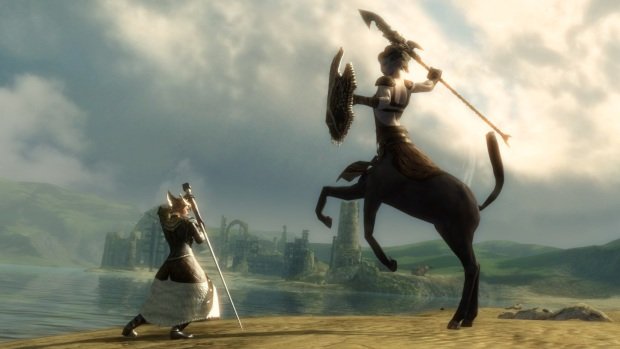Guild Wars 2 closed beta preview
How the event system will change the way you quest
There’s no traditional healer class in Guild Wars 2, breaking up the usual dynamic requiring a tank to hold aggression, a DPS class to pour out the damage, and a healer to keep everyone alive. Instead, every class gets a utility skill slot in their action bar, which can be loaded up with a variety of healing skills to keep you alive. If that fails, the combat system has been updated with a mini-game of sorts called “Fight to Survive!” Should you go down, the screen will zoom in on your fallen character and your skill bar will be replaced with a new set of commands as you slowly bleed out. While in this survival-like mode, you can throw a rock at an enemy for a small amount of damage or lob a hammer to temporarily stun an enemy. You can also select a skill that will slowly regenerate your health as it channels. Last long enough, or get a helping hand from a nearby player, and you’ll be back in battle.
The Fight to Survive mode isn’t just great for the second chance it offers. It keeps the momentum of battle going, especially in large world events where lots of players are fighting and falling – and cuts down on the downtime when you die. There is no resurrection sickness of any sort or low morale that follows failure in most MMOs. Instead, you can always jump straight back into battle. Even if you find yourself in a tight spot where you fail to survive and no one’s around to revive you, you can almost always quickly respawn at a nearby checkpoint to get back to the fight.
Above: A quick look at how the Fight to Survive mode lets you rally for a second chance
While the Charr starting experience was impressive, what’s really exciting is how the pacing of the game continues to ramp up once you’re set free to begin exploring. Shortly after we ventured out of the Black Citadel, the Charr starting city that’s shaped like a giant metal sphere, we see Guild Wars 2’s event system come to life. Scout NPCs introduce the major threats in the area that need your attention. Discover a new outpost or town, and you may find yourself in the middle of an event, tasking you to join forces with nearby players and NPCs to fight off waves of attacking Centaur. Lighter hearted events are also available, with one finding you helping to celebrate a meat festival by passing mead and meat skewers to thirsty and hungry guards.
As you continue adventuring, you’ll also find more epic events relating to contested areas on the map. In one instance, we came across the town of Nageling, which had been singlehandedly conquered by a giant. Standing head and shoulders above most nearby buildings, the outpost was a wasteland full of fallen NPC soldiers. At our level, to take on the giant on our own would have been the end of us. But because events are broadcasted within the zone, every nearby player is notified about the need to retake the town – and before we knew it, there were about a dozen players naturally drawn towards the conflict. With a large group, players split up with some reviving fallen soldier NPCs to join the battle, while others laid down ranged damage, raining down arrows, musket fire, and spells on the giant.
Above: The final stage of a lengthy event that climaxes with a boss fight. Look at how many players there are and remember that with the event system, battles like this are happening all the time and everywhere

Retaking the town and seeing that giant fall to its knees felt great – and really speaks to the way the event system works so smoothly. Tyria is truly reborn and feels alive with adventure. With every step you take, there’s a good chance that there’s a huge battle brewing just around the corner or over the next hill. And it’s good to point out that everything we experienced so far was either while we were at or below level 20. With Guild Wars 2’s level cap tentatively slated for 80, it makes us very optimistic about the mid and upper level content to follow when Guild Wars 2 launches later this year.
Sign up to the GamesRadar+ Newsletter
Weekly digests, tales from the communities you love, and more



